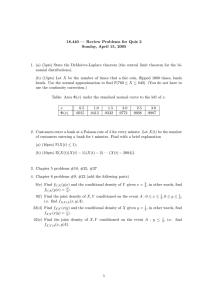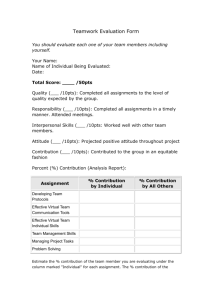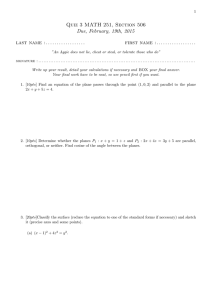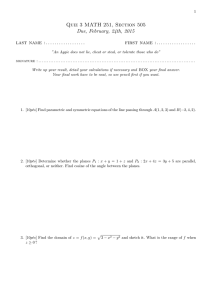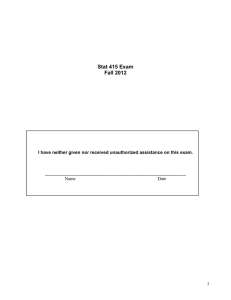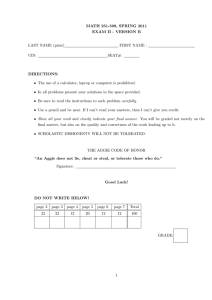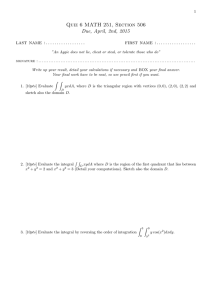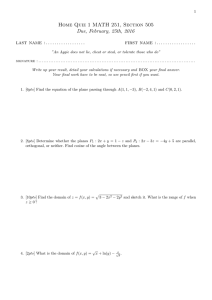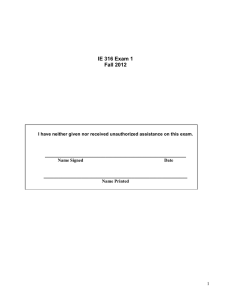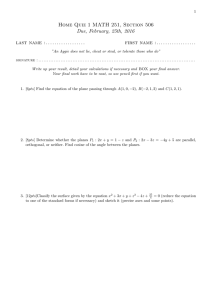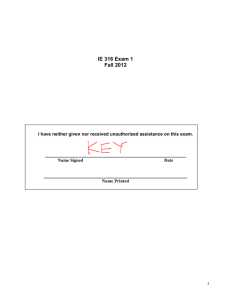IE 361 Exam 3 Fall 2012 ________________________________________________________
advertisement
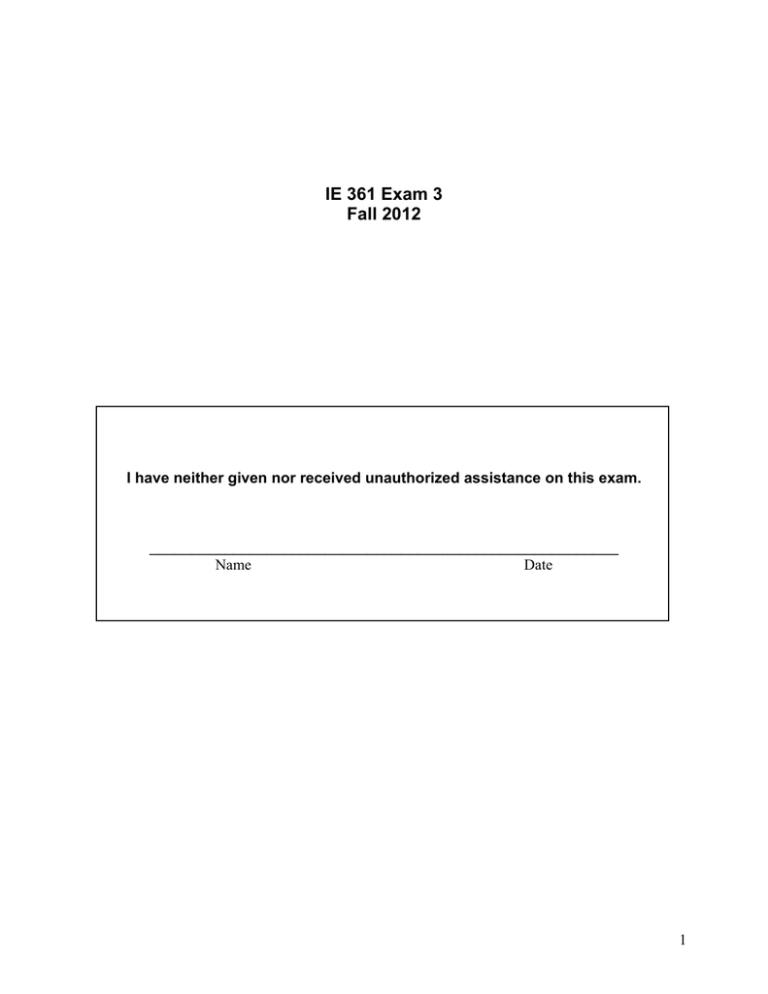
IE 361 Exam 3 Fall 2012 I have neither given nor received unauthorized assistance on this exam. ________________________________________________________ Name Date 1 1. I wish to measure the density of a small rock. My method is to read the volume of water in a graduated cylinder before and after putting the rock into the cylinder, producing v1 = volume read without the rock and v2 = volume read with the rock and then to measure the mass, m , of the rock on a precision balance. Ultimately, I will use the relationship m d= v2 − v1 to compute density. Suppose that v1 ≈ 65 ml and v2 ≈ 75 ml and that volumes can be determined with a standard deviation around .5 ml . Further, m ≈ 27.2 g and mass can be determined with a standard deviation around .1 g . 15pts a) What are an approximate mean and standard deviation of measured density? By the way, partial derivatives of d are: ∂d 1 ∂d −m ∂d m = , = , and = 2 ∂m v2 − v1 ∂v2 ( v2 − v1 ) ∂v1 ( v2 − v1 )2 mean: _______________ 5pts standard deviation: _______________ b) For measuring the density of this particular rock, is the imprecision of the graduated cylinder more or less important than the imprecision of the balance (in terms of producing uncertainty in the measured density)? Explain. most important (circle one): cylinder/balance Explanation: 2 2. The rest of this exam concerns analysis of some data taken from the NIST website, http://www.itl.nist.gov/div898/handbook/toolaids/pff/pri.pdf The data are from an experiment conducted on the operation of a toy catapult used to launch golf balls. Here's a picture of the device (also take from the NIST website). The response variable was y = measured golf ball flight distance (inches) and the effects of 5 physical parameters were studied. The variables considered were A--band height B--start angle C--rubber bands D--arm length E--stop angle (height of pivot point for bands above the surface of the device (inches)) (location of the arm at the beginning of launch (degrees from horizontal)) (number of bands used) (distance an "extension" setting on the arm (inches)), and (the angle at which rotation of the arm is stopped (degrees from horizontal)) The last page of the exam provides a printout of a JMP data table giving all the data collected in the experiment. We will use various parts of the data set as we go through this question. 10pts a) Among the 20 trials there were 18 different set-ups of the catapult. Runs #2 and #13 were from the same set-up and produced measured distances of 99.0 and 84.5 inches, while runs #7 and #19 were from a different single set-up and produced measured distances of 45 and 37.5 inches. Give a single number estimate of the standard deviation of measured flight distance for any fixed set-up and its degrees of freedom. estimate: _______________ degrees of freedom: _______________ 3 10pts b) Give 95% confidence limits for the standard deviation of measured flight distance for any fixed set-up. (Plug in completely, but you need not simplify.) 10pts c) Two of the sample sizes in the study were ni = 2 and the other 16 were ni = 1 . Thus there are two different (95%) "margins of error" that might be associated with any one of the 18 different "sample means" from the study. Give their values. ni = 2 margin of error for yi ni = 1 margin of error for yi | | | | | | | | | | | 10pts d) The quantity y00+ 00 − y00−00 (the sample average for runs #2 and #13 minus the sample average for runs #7 and #19) is a measure of the effect of moving from 1 band to 2 bands (with all other variables held fixed at their "center" experimental values). Give 95% confidence limits based on this difference (note that y00+ 00 − y00−00 = 50.5 ) for the difference in population means. Does this give clear evidence of a difference in mean flight distance with the addition of the second band? limits: _________________ detectable difference? _______________ 4 10pts e) If one considers only 1 band and arm length 0, the 4 values below were obtained (written in Yates order for Factors A and E). Use the Yates algorithm and find 4 fitted effects A-band height E-stop angle 10pts y (−) (3.25) (−) (45) 8 (+ ) (4.75) (−) (45) 35 (−) (3.25) (+) (80) 28 (+ ) (4.75) (+ ) (80) 28.25 f) Notice that the start angles (levels of Factor B) corresponding to the y's above are (in the order the observations are written top to bottom) ( +, −, −, + ) i.e. ( 20, 0, 0, 20 ) . In light of this fact, what are two plausible interpretations of the set of values you produced in part e) for how the catapult operates (with 1 band and arm length set at 0)? Interpretation 1: Interpretation 2: 10pts g) The 16 set-ups in the experiment excluding runs 2,7,13,19 constitute a standard half fraction of a full 25 factorial. If one were to run the corresponding responses through the Yates algorithm to produce fitted sums of effects, Ê , how big would one of those need to be in order to represent a statistically detectable sum? (Make use of your estimate from part a) and 95% confidence.) 5 4 10pts h) In light of your answer to g), the 16 = 2 fitted effects in the JMP report below, and the fact that half-fraction data are being analyzed here, interpret the results of the 25−1 fractional factorial part of this data set. Say clearly what assumptions you are making about likely simplicity of the physical situation. NIST Catapult Data 6
